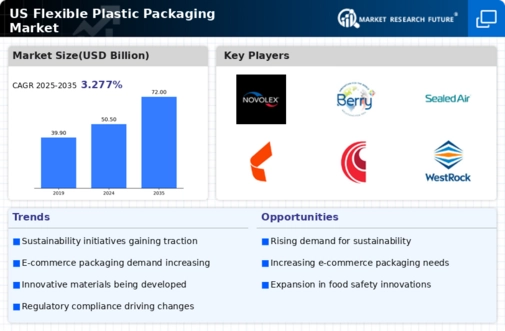Growth in E-Commerce and Online Retail
The flexible plastic-packaging market is significantly influenced by the rapid growth of e-commerce and online retail. As more consumers opt for online shopping, the demand for efficient and protective packaging solutions has surged. In 2025, e-commerce sales in the US are expected to reach approximately $1 trillion, necessitating innovative packaging solutions that ensure product safety during transit. Flexible plastic packaging offers lightweight and durable options that cater to the needs of e-commerce businesses, thereby driving growth in the flexible plastic-packaging market. This trend highlights the importance of packaging in enhancing customer experience and reducing shipping costs, which are critical factors for online retailers.
Technological Innovations in Packaging
The flexible plastic-packaging market is benefiting from ongoing technological innovations that enhance packaging performance and functionality. Advances in materials science and manufacturing processes are enabling the development of lighter, stronger, and more versatile packaging solutions. Innovations such as smart packaging, which incorporates sensors to monitor product conditions, are gaining traction within the flexible plastic-packaging market. These technologies not only improve product safety but also provide valuable data to manufacturers and consumers alike. As companies continue to invest in these advancements, the flexible plastic-packaging market is likely to see increased efficiency and reduced waste, further driving its growth.
Rising Demand for Eco-Friendly Solutions
The flexible plastic-packaging market is experiencing a notable shift towards eco-friendly solutions, driven by increasing consumer awareness regarding environmental sustainability. As more consumers demand sustainable packaging options, companies are compelled to innovate and adopt biodegradable materials. This trend is reflected in the market, where the demand for sustainable packaging solutions is projected to grow at a CAGR of approximately 5.5% through 2026. The flexible plastic-packaging market is adapting to these changes by investing in research and development to create materials that minimize environmental impact while maintaining functionality. This shift not only addresses consumer preferences but also aligns with regulatory pressures aimed at reducing plastic waste, thereby enhancing the industry's overall sustainability profile.
Increased Focus on Food Safety and Shelf Life
The flexible plastic-packaging market is witnessing a heightened emphasis on food safety and extending shelf life. As consumers become more health-conscious, the demand for packaging that preserves food quality and safety is rising. Flexible plastic packaging provides excellent barrier properties, protecting products from moisture, oxygen, and contaminants. This is particularly crucial in the food sector, where the flexible plastic-packaging market is projected to grow by approximately 4% annually through 2026. The ability of flexible packaging to enhance product freshness and safety aligns with consumer preferences for convenience and quality, thereby driving market growth.
Regulatory Changes and Compliance Requirements
The flexible plastic-packaging market is increasingly shaped by evolving regulatory changes and compliance requirements aimed at reducing plastic waste and promoting recycling. Governments are implementing stricter regulations regarding packaging materials, which compel companies to adapt their practices. In the US, initiatives aimed at reducing single-use plastics are influencing the flexible plastic-packaging market, pushing manufacturers to explore alternative materials and sustainable practices. Compliance with these regulations not only helps companies avoid penalties but also enhances their brand reputation among environmentally conscious consumers. As a result, the flexible plastic-packaging market is likely to experience a shift towards more sustainable and compliant packaging solutions.






















Leave a Comment